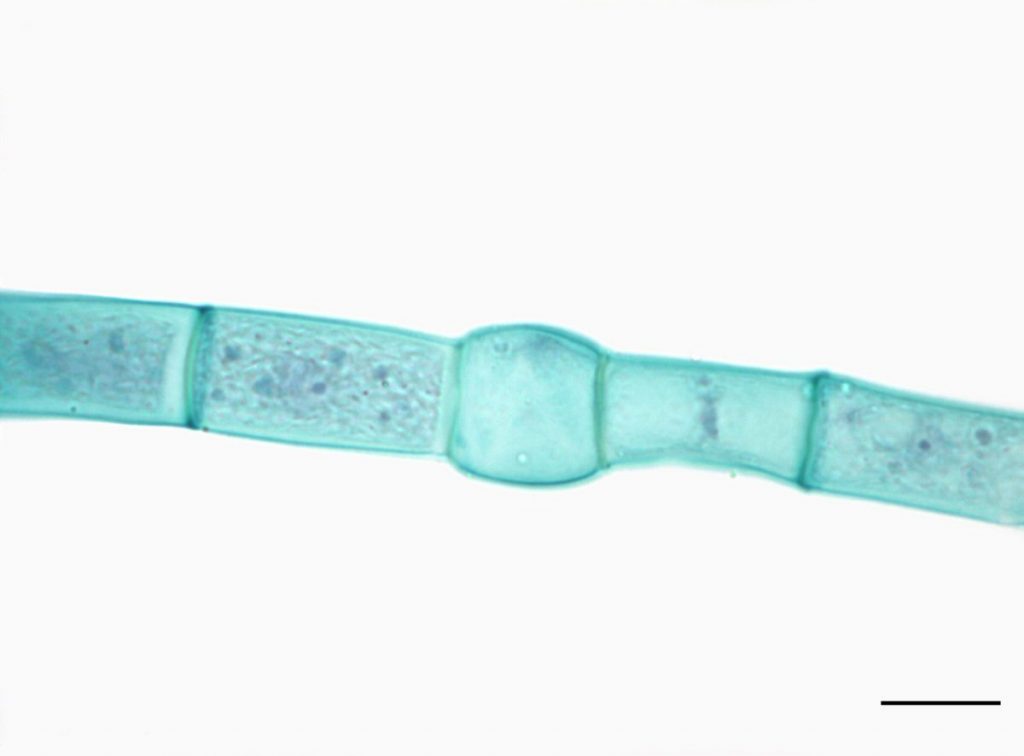Oedogonium: a filamentous green algae

Oedogonium is representative of a number of organisms in a very diverse group, the green algae (Chlorophyta). In this book we consider several members of the green algae that illustrate a range in form and structure. Other members of the green algae group are Chlamydomonas (small and unicellular), Acetabularia (large and unicellular) and Caulerpa (large and coenocytic) , which are quite different in form and structure.
Taxonomy and Phylogeny
The green algae (= Chlorophyta) are a group of eukaryotes that have some characteristics in common with plants (they are photosynthetic, possess both chlorophyll a and b, generally store carbohydrate as starch and have cellulose cell walls). But they also differ from plants in several ways: almost all are not multicellular, being either unicellular, siphonaceous or filamentous; they do not retain embryos inside the previous generation as all plants do; few grow on land as almost all plants do. Because land plants are thought to have originated from ancestral ‘green-algal like organisms’ separating green algae and plants in separate kingdoms, as is done in the ‘five-Kingdom’ classification, with a Protist Kingdom that includes green algae and a separate Plant Kingdom, is very artificial. One remedy is to put green algae in the plant kingdom and some observers do this. Another alternative is to simply throw out the Kingdom level of taxonomy and this is what many modern treatments do. If this were done then one might split the green algae into two phyla, one that includes land plants (Streptophyta) and one that doesn’t (Chlorophyta), which would include Oedogonium.
Structure
Oedogonium forms elongate filaments of cells, m ost of which are non-flagellated, cylindrical and have a cell wall that contains both cellulose and chitin. These cells are vegetative, i.e. are not associated with reproduction but only associated with photosynthesis and growth of the filament. Several additional cell types are produced that bring about reproduction and sex:
- zoospores — mobile, flagellated cells do not have cellulose cell walls. Zoospores are released from parental cells and can attach to various substrates, becoming immobile and dividing to form new filaments. Zoospores have contractile vacuoles; why do you think this is the case?
- oogonia — large cells that develop a pore in the cell wall that allows flagellated sperm cells to enter the cell
- sperm — mobile, flagellated cells that are released from parental cells and swim to the oogonia
- zygospores — produced after sperm fertilize eggs, these cells develop a thick cell wall. They eventually undergo meiosis and break open to release flagellated zoospores.
Reproduction
Oedogonium reproduces asexually via mobile zoospores and sexual ly via sperm, oogonia and zygospores. Sperm are released from parental cells and are chemo-attracted to the oogonia that house an egg. A pore in the oogonium cell wall allows the sperm to enter the oogonium and fertilize the egg. Fertilization occurs and the oogonium develops a thick wall, forming a structure called a zygospore. Eventually the cell inside the zygospore undergo meiosis and haploid daughter cells are released as mobile zoospores, which, like the zoospores produced asexually, swim to a substrate and attach themselves and elongate into filaments.

Matter and energy
Oedogonium is a typical photoautotroph, using the energy of sunlight to synthesize carbohydrates from carbon dioxide and then using the carbohydrates as an energy source in cellular respiration and as building materials to synthesize a variety of biomolecules.
Interactions
Oedogonium is common in in fresh water habitats. It is eaten by a variety of herbivores including fish, mollusks and other invertebrates.
Further Reading
- “The Filamentous Algae” on Micrographia
- Oedogonium Image-based Key
- Observations of Oedogonium and chytrids
- Article on the evolution of green algae
Media Attributions
- Oedogonium © Jon Houseman and Matthew Ford is licensed under a CC BY-SA (Attribution ShareAlike) license

